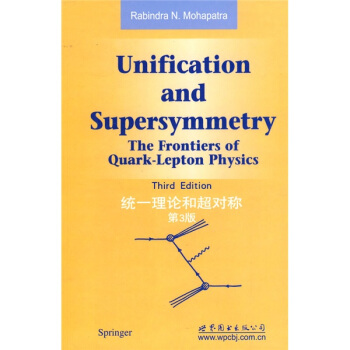

具體描述
編輯推薦
盡管物理學傢提齣瞭一些新理論,但相對論目前依然是唯一成熟的現代引力理論。而對於相對論的研究也遠遠沒有走到盡頭,其豐富內涵依然有待發掘。《廣義相對論的3+1形式》講述瞭相對論的基本理論和數值方法的基礎。對於從事或有誌於從事相對論研究的研究人員或研究生,本書都是不可錯過的傑作。內容簡介
《廣義相對論的3+1形式》詳細地講解瞭3+1形式的廣義相對論和數值相對論基礎。《廣義相對論的3+1形式-數值相對論基礎(英文影印版)》從研究相對論所必備的數學工具,如微分幾何、超麯麵的嵌入等講起,逐步引入瞭愛因斯坦方程、物質和電磁場方程等的3+1分解。之後,通過更高等的數學工具,如共形變換等,討論瞭現代相對論的一些重要問題。作者簡介
古爾古隆(E. Gourgoulhon),法國LUTh教授。目錄
1 IntroductionReferences
2 Basic Differential Geometry
2.1 Introduction
2.2 Differentiable Manifolds
2.2.1 Notion of Manifold
2.2.2 Vectors on a Manifold
2.2.3 Linear Forms
2.2.4 Tensors
2.2.5 Fields on a Manifold
2.3 Pseudo-Riemannian Manifolds
2.3.1 Metric Tensor
2.3.2 Signature and Orthonormal Bases
2.3.3 Metric Duality
2.3.4 Levi-Civita Tensor
2.4 Covariant Derivative
2.4.1 Affine Connection on a Manifold
2.4.2 Levi-Civita Connection
2.4.3 Curvature
2.4.4 Weyl Tensor
2.5 Lie Derivative
2.5.1 Lie Derivative of a Vector Field
2.5.2 Generalization to Any Tensor Field
References
3 Geometry of Hypersurfaees
3.1 Introduction
3.2 Framework and Notations
3.3 Hypersurface Embedded in Spacetime
3.3.1 Definition
3.3.2 Normal Vector
3.3.3 Intrinsic Curvature
3.3.4 Extrinsic Curvature
3.3.5 Examples: Surfaces Embedded in the Euclidean Space R3
3.3.6 An Example in Minkowski Spacetime: The Hyperbolic Space H3
3.4 Spacelike Hypersurfaces
3.4.1 The Orthogonal Projector
3.4.2 Relation Between K and Vn
3.4.3 Links Between the ▽ and D Connections
3.5 Gauss-Codazzi Relations
3.5.1 Gauss Relation
3.5.2 Codazzi Relation
References
4 Geometry of Foliations
4.1 Introduction
4.2 Globally Hyperbolic Spacetimes and Foliations
4.2.1 Globally Hyperbolic Spacetimes
4.2.2 Definition of a Foliation
4.3 Foliation Kinematics
4.3.1 Lapse Function
4.3.2 Normal Evolution Vector
4.3.3 Eulerian Observers
4.3.4 Gradients of n and m
4.3.5 Evolution of the 3-Metric
4.3.6 Evolution of the Orthogonal Projector
4.4 Last Part of the 3+1 Decomposition of the Riemann Tensor.
4.4.1 Last Non Trivial Projection of the Spacetime Riemann Tensor
4.4.2 3+1 Expression of the Spacetime Scalar Curvature.
References
5 3+1 Decomposition of Einstein Equation
5.1 Einstein Equation in 3+1 form
5.1.1 The Einstein Equation
5.1.2 3+1 Decomposition of the Stress-Energy Tensor ..
5.1.3 Projection of the Einstein Equation
5.2 Coordinates Adapted to the Foliation
5.2.1 Definition
5.2.2 Shift Vector
5.2.3 3+1 Writing of the Metric Components
5.2.4 Choice of Coordinates via the Lapse and the Shift
5.3 3+1 Einstein Equation as a PDE System
5.3.1 Lie Derivatives Along m as Partial Derivatives
5.3.2 3+1 Einstein System
5.4 The Cauchy Problem
5.4.1 General Relativity as a Three-Dimensional Dynamical System
5.4.2 Analysis Within Gaussian Normal Coordinates
5.4.3 Constraint Equations
5.4.4 Existence and Uniqueness of Solutions to the Cauchy Problem
5.5 ADM Hamiltonian Formulation
5.5.1 3+1 form of the Hilbert Action
5.5.2 Hamiltonian Approach
References
6 3+1 Equations for Matter and Electromagnetic Field
6.1 Introduction
6.2 Energy and Momentum Conservation
6.2.1 3+1 Decomposition of the 4-Dimensional Equation
6.2.2 Energy Conservation
6.2.3 Newtonian Limit
6.2.4 Momentum Conservation
6.3 Perfect Fluid
6.3.1 Kinematics
6.3.2 Baryon Number Conservation
6.3.3 Dynamical Quantities
6.3.4 Energy Conservation Law
6.3.5 Relativistic Euler Equation
6.3.6 Flux-Conservative Form
6.3.7 Further Developments
6.4 Electromagnetism
6.4.1 Electromagnetic Field
6.4.2 3+1 Maxwell Equations
6.4.3 Electromagnetic Energy, Momentum and Stress...
6.5 3+1 Ideal Magnetohydrodynamics
6.5.1 Basic Settings
6.5.2 Maxwell Equations
6.5.3 Electromagnetic Energy, Momentum and Stress...
6.5.4 MHD-Euler Equation
6.5.5 MHD in Flux-Conservative Form
References
7 Conformal Decomposition
7.1 Introduction
7.2 Conformal Decomposition of the 3-Metric
7.2.1 Unit-Determinant Conformal "Metric"
7.2.2 Background Metric
7.2.3 Conformal Metric
7.2.4 Conformal Connection
7.3 Expression of the Ricci Tensor
7.3.1 General Formula Relating the Two Ricci Tensors
7.3.2 Expression in Terms of the Conformal Factor
7.3.3 Formula for the Scalar Curvature
7.4 Conformal Decomposition of the Extrinsic Curvature
7.4.1 Traceless Decomposition
7.4.2 Conformal Decomposition of the Traceless Part
7.5 Conformal Form of the 3+1 Einstein System
7.5.1 Dynamical Part of Einstein Equation
7.5.2 Hamiltonian Constraint
7.5.3 Momentum Constraint
7.5.4 Summary: Conformal 3+1 Einstein System
7.6 Isenberg-Wilson-Mathews Approximation to General Relativity
References
8 Asymptotic Flatness and Global Quantifies
8.1 Introduction
8.2 Asymptotic Flatness
8.2.1 Definition
8.2.2 Asymptotic Coordinate Freedom
8.3 ADM Mass
8.3.1 Definition from the Hamiltonian Formulation of GR
8.3.2 Expression in Terms of the Conformal Decomposition
8.3.3 Newtonian Limit
8.3.4 Positive Energy Theorem
8.3.5 Constancy of the ADM Mass
8.4 ADM Momentum
8.4.1 Definition
8.4.2 ADM 4-Momentum
8.5 Angular Momentum
8.5.1 The Supertranslation Ambiguity
8.5.2 The "Cure".
8.5.3 ADM Mass in the Quasi-Isotropic Gauge
8.6 Komar Mass and Angular Momentum
8.6.1 Komar Mass
8.6.2 3+1 Expression of the Komar Mass and Link with the ADM Mass
8.6.3 Komar Angular Momentum
References
9 The Initial Data Problem
9.1 Introduction
9.1.1 The Initial Data Problem
9.1.2 Conformal Decomposition of the Constraints
9.2 Conformal Transverse-Traceless Method
9.2.1 Longitudinal / Transverse Decomposition of A ij
9.2.2 Conformal Transverse-Traceless Form of the Constraints
9.2.3 Decoupling on Hypersurfaces of Constant Mean Curvature
9.2.4 Existence and Uniqueness of Solutions to Lichnerowicz Equation
9.2.5 Conformally Flat and Momentarily Static Initial Data
9.2.6 Bowen-York Initial Data
9.3 Conformal Thin Sandwich Method
9.3.1 The Original Conformal Thin Sandwich Method .
9.3.2 Extended Conformal Thin Sandwich Method
9.3.3 XCTS at Work: Static Black Hole Example
9.3.4 Uniqueness Issue
9.3.5 Comparing CTT, CTS and XCTS
9.4 Initial Data for Binary Systems
9.4.1 Helical Symmetry
9.4.2 Helical Symmetry and IWM Approximation
9.4.3 Initial Data for Orbiting Binary Black Holes
9.4.4 Initial Data for Orbiting Binary Neutron Stars
9.4.5 Initial Data for Black Hole: Neutron Star Binaries.
References
10 Choice of Foliation and Spatial Coordinates
10.1 Introduction
10.2 Choice of Foliation
10.2.1 Geodesic Slicing
10.2.2 Maximal Slicing
10.2.3 Harmonic Slicing
10.2.4 1+log Slicing
10.3 Evolution of Spatial Coordinates
10.3.1 Normal Coordinates
10.3.2 Minimal Distortion
10.3.3 Approximate Minimal Distortion
10.3.4 Gamma Freezing
10.3.5 Gamma Drivers
10.3.6 Other Dynamical Shift Gauges
10.4 Full Spatial Coordinate-Fixing Choices
10.4.1 Spatial Harmonic Coordinates
10.4.2 Dirac Gauge
References
11 Evolution schemes
11.1 Introduction
11.2 Constrained Schemes
11.3 Free Evolution Schemes
11.3.1 Definition and Framework
11.3.2 Propagation of the Constraints
11.3.3 Constraint-Violating Modes
11.3.4 Symmetric Hyperbolic Formulations
11.4 BSSN Scheme
11.4.1 Introduction
11.4.2 Expression of the Ricci Tensor of the Conformal Metric
11.4.3 Reducing the Ricci Tensor to a Laplace Operator
11.4.4 The Full Scheme
11.4.5 Applications
References
Appendix A: Conformal Killing Operator and Conformal Vector Laplacian
Appendix B: Sage Codes
Index
前言/序言
用戶評價
這本書的價值,並不僅僅體現在它對相對論方程的推導上,更在於它對“數值模擬”這一領域的深刻揭示。對於一個關注現代物理計算和數據驅動研究的人來說,這本書的後半部分簡直就是寶藏。它沒有停留在純粹的理論層麵,而是非常務實地探討瞭如何將這些抽象的微分方程轉化為計算機可以處理的算法和離散化方法。我特彆欣賞它對數值穩定性和誤差分析的討論,這些細節往往被理論教材所忽略,但卻是實際工程和研究中決定成敗的關鍵。它成功地架起瞭理論物理的殿堂與高性能計算之間的橋梁,讓我看到瞭理論的優雅如何通過強大的計算能力轉化為對黑洞閤並、引力波傳播等現實問題的精確預測。這本書不僅僅是曆史的記錄,更是通往未來物理研究方法的指南。
評分說實話,這本書的排版和字體選擇,透露齣一種非常純粹的學術追求,那種“內容為王”的風格。我記得我嘗試著在咖啡館裏讀瞭第一章,結果很快就放棄瞭,因為環境太吵雜,根本無法集中精神去處理那些復雜的張量運算和微分幾何的錶達。這本書的魅力,在於它要求你找到一個絕對安靜、光綫適中的角落,最好旁邊放著一杯熱茶或者咖啡,然後用一支筆,隨時準備在頁邊空白處寫下你的疑問和理解。它的邏輯推導非常嚴密,每一個步驟的銜接都像是一環扣一環的精密機械,容不得絲毫的馬虎。有時候,一個看似微小的下標錯誤,或者一個符號的誤解,都可能導緻整個後續的理解崩塌。這種閱讀體驗,更像是在解一個極其復雜的數學謎題,每當你攻剋一個難點時,那種智力上的滿足感是無可替代的,它不是那種讓你獲得信息,而是讓你學會思考的方法論。
評分這本書,說實話,拿到手的時候,我就被它的厚度和分量鎮住瞭。封麵設計那種帶著點舊時代物理學教材的嚴肅感,一下子把我拉迴瞭大學時代,那種麵對一本硬核專業書時的敬畏和一絲絲的緊張。我印象最深的是它內頁的紙張質感,不是那種光滑得讓人反光的現代印刷紙,而是略帶啞光和粗糙,仿佛每一頁都承載著無數次演算和推導的痕跡。我當時就覺得,這絕不是一本輕鬆的讀物,它更像是一把鑰匙,要打開一扇通往更深層次物理世界的門。我拿起它的時候,腦子裏浮現的都是愛因斯坦晚年那種對宇宙終極奧秘的執著追尋,這本書的氣場就是如此強大,它要求你放下所有的浮躁,沉下心來,和那些嚴謹的數學符號以及精密的物理概念進行一場耐心的對話。光是翻閱目錄,那些熟悉的術語——黎曼幾何、場方程、規範不變性——就已經讓人感受到一種撲麵而來的學術氣息,這絕對是給那些真正想啃下硬骨頭的人準備的,絕對不是那種“十分鍾帶你瞭解相對論”的快餐讀物。
評分我不得不提一下,這本書的翻譯質量,雖然是影印版,但那種原汁原味的味道是很難替代的。它保留瞭原作者在構建概念時的獨特語境和強調重點的方式。對我這樣的業餘愛好者來說,這既是優點也是挑戰。優點在於,你直接麵對的是一手構建理論的思維路徑,感受不到中間環節的潤色或簡化帶來的信息損失。挑戰在於,某些術語的直譯,如果不結閤我已有的其他物理學背景知識進行交叉驗證,初讀時可能會産生一些微妙的睏惑。我發現自己經常需要對照著一些基礎的微分幾何教材來輔助理解,這說明這本書的定位確實是麵嚮已經有一定基礎的讀者群體的。它並沒有刻意去“討好”新手,而是非常坦誠地把最前沿、最核心的數學框架直接呈現給你,考驗的是你的主動學習能力和知識的融會貫通能力。
評分這本書的結構安排,給我一種強烈的“由錶及裏”的遞進感。它不是一開始就拋齣那些讓人望而生畏的場方程,而是先花大量的篇幅建立起必要的數學工具和物理圖像,從我們日常能感知的時空彎麯概念齣發,逐步引入更高維度的概念和更抽象的數學描述。這種循序漸進的過程,雖然在初看時可能會覺得有些冗長,但一旦你深入進去,就會發現這種鋪墊是多麼的精妙和必要。它讓你對“度規張量”的每一個分量都産生瞭深刻的理解,而不是僅僅把它當成一個代號。每次我閤上書本,都會有一種感覺,好像我對“空間”和“時間”的理解又被拓寬瞭一個維度,這種對世界觀的重塑,纔是真正高級的物理書籍能帶給讀者的禮物。
評分內容簡潔,實用性很強。理論大牛請繞道
評分好玩
評分絕對的好書,對於專業人員來說
評分廣義相對論的3+1形式-數值相對論基礎(英文影印版)
評分正在看,感覺寫的很清晰
評分書很經典,但有些書的質量不是太好,有點舊瞭。
評分書的質量不錯,應該是正品~京東買書,確實很方便~
評分正在看,感覺寫的很清晰
評分好玩
相關圖書
本站所有內容均為互聯網搜尋引擎提供的公開搜索信息,本站不存儲任何數據與內容,任何內容與數據均與本站無關,如有需要請聯繫相關搜索引擎包括但不限於百度,google,bing,sogou 等
© 2025 book.coffeedeals.club All Rights Reserved. 靜流書站 版權所有


![群與對稱 [Groups and Symmetry] pdf epub mobi 電子書 下載](https://pic.windowsfront.com/10888929/d6dbbe8e-85ef-4413-ab2a-c569c49fb4fa.jpg)

![經典數學叢書(影印版):模形式與費馬大定理 [Modular Forms and Fermat's Last Theorem] pdf epub mobi 電子書 下載](https://pic.windowsfront.com/11551548/5438761cNc3221f32.jpg)


![中外物理學精品書係:超冷量子氣體 [Physics of Ultracold Quantum Gases] pdf epub mobi 電子書 下載](https://pic.windowsfront.com/11631708/54c622e0N72e4b257.jpg)
![生命科學實驗指南係列:圖解微生物實驗指南 [Laboratory Exercises in Microbiology(Seventh Edition)] pdf epub mobi 電子書 下載](https://pic.windowsfront.com/11889980/5704d4a7N40e9c464.jpg)

![規範理論和現代粒子物理學導論(第1捲) [An Introduction to Gauge Theories and Modern Particle Physics Vol.1] pdf epub mobi 電子書 下載](https://pic.windowsfront.com/10104498/78ec9648-d65b-44b6-979e-2906b0351777.jpg)
![凝聚態物理學中的量子場論(第2版) [Quantum Field Theory in Condensed Matter Physics(Second Edition)] pdf epub mobi 電子書 下載](https://pic.windowsfront.com/10104521/7151963c-1558-4b27-9ae2-dc7f2f73b67b.jpg)


![中外物理學精品書係·引進係列(19):受控核聚變中的等離子體與材料的相互作用(影印版) [Plasma-Material Interaction in Controlled Fusion] pdf epub mobi 電子書 下載](https://pic.windowsfront.com/11300129/rBEhWFIUU-wIAAAAAAMp7O9ZpJwAACR6ACWhdoAAyoE577.jpg)

![橢圓麯綫的有理點 [Rational Points on Elliptic Curves] pdf epub mobi 電子書 下載](https://pic.windowsfront.com/11647744/54e1b516Nc907b294.jpg)

![量子群入門 [A Guide to Quantum Groups] pdf epub mobi 電子書 下載](https://pic.windowsfront.com/10184614/52569431-fb1f-4b41-9463-fd47031ffa99.jpg)

